EMSS clusters with giant arcs
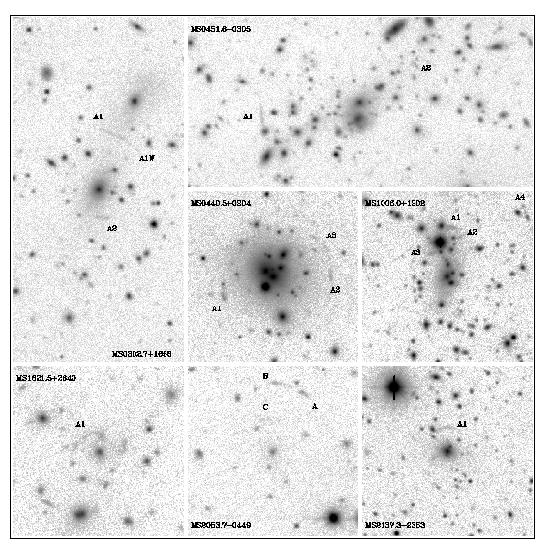 The composite picture shows seven out of eight EMSS clusters with
giant arcs. The CCD imaging survey for gravitational lensing was
carried out with the University of Hawaii (UH) 2.2 m telescope and
the Canada France Hawaii telescope (CFHT) on Mauna Kea.
The sample consists of the most X-ray luminous
(Lx > 2x10^44 erg/s) EMSS clusters that are
observable from Mauna Kea (declination > -40deg), and spans a
redshift range of 0.15 < z < 0.823 with 5 clusters at z > 0.5.
CCD images of the clusters were obtained in excellent seeing.
Evidence for strong gravitational lensing in the form of giant arcs
(length l > 8'', axis ratio l/w > 10) is present in 8 of the 38 clusters.
Images are published in
Luppino, Gioia, Hammer, Le Fevre & Annis, 1999.
The composite picture shows seven out of eight EMSS clusters with
giant arcs. The CCD imaging survey for gravitational lensing was
carried out with the University of Hawaii (UH) 2.2 m telescope and
the Canada France Hawaii telescope (CFHT) on Mauna Kea.
The sample consists of the most X-ray luminous
(Lx > 2x10^44 erg/s) EMSS clusters that are
observable from Mauna Kea (declination > -40deg), and spans a
redshift range of 0.15 < z < 0.823 with 5 clusters at z > 0.5.
CCD images of the clusters were obtained in excellent seeing.
Evidence for strong gravitational lensing in the form of giant arcs
(length l > 8'', axis ratio l/w > 10) is present in 8 of the 38 clusters.
Images are published in
Luppino, Gioia, Hammer, Le Fevre & Annis, 1999.
- Back to Isabella home page
Color images of EMSS clusters with gravitational lenses
MS0440+0204
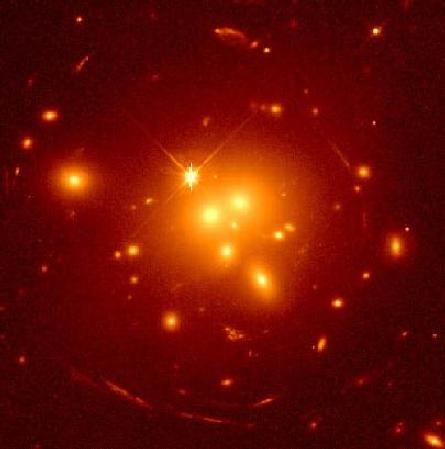 HST image of the X-ray selected cluster
MS0440+0204 obtained from
10 exposures on consecutive orbits with the WFPC2 camera and the
F702W (R) filter for a total integration time of 22,200 sec.
The field of view is 51.2x51.2 arcsec corresponding to 209x209 kpc
(Ho=50, qo=0.5) at the redshift of the cluster (z=0.196).
The figure
(Gioia et al. 1998)
shows both the multiple nucleus cD galaxy and the spectacular arc system with
over 20 arcs symmetrically distributed to draw almost perfect circles around
the cluster center. Models of the cluster mass distribution and its lensing
properties reveal 5 background sources at various redshifts each forming 2 or
more arcs. Using these data, limits have been derived to the mass distribution
in the range 50-100 kpc (possible range in projected mass is (6.6 - 9.5)
10^13 solar masses).
HST image of the X-ray selected cluster
MS0440+0204 obtained from
10 exposures on consecutive orbits with the WFPC2 camera and the
F702W (R) filter for a total integration time of 22,200 sec.
The field of view is 51.2x51.2 arcsec corresponding to 209x209 kpc
(Ho=50, qo=0.5) at the redshift of the cluster (z=0.196).
The figure
(Gioia et al. 1998)
shows both the multiple nucleus cD galaxy and the spectacular arc system with
over 20 arcs symmetrically distributed to draw almost perfect circles around
the cluster center. Models of the cluster mass distribution and its lensing
properties reveal 5 background sources at various redshifts each forming 2 or
more arcs. Using these data, limits have been derived to the mass distribution
in the range 50-100 kpc (possible range in projected mass is (6.6 - 9.5)
10^13 solar masses).
MS2137-2353
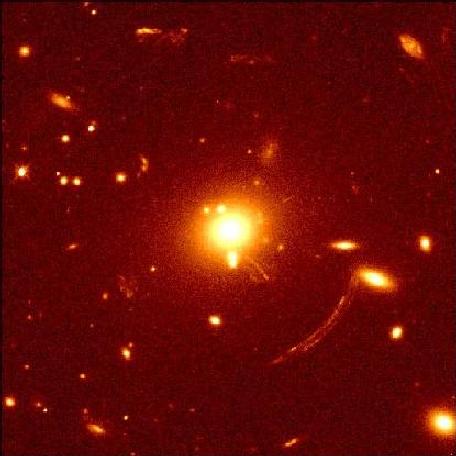 HST image of the X-ray selected cluster
MS2137-2353
(Hammer, Gioia et al. 1997)
obtained from 10 exposures on consecutive orbits with the WFPC2 camera and
the F702W (R) filter for a total integration time of 22,200 sec.
The field of view is 51.2x51.2
arcsec corresponding to 288x288 kpc (Ho=50, qo=0.5) at the redshift of the
cluster (z=0.31). Even if less spectacular than MS0440+0204 in number of arcs,
this cluster has the first example of radial arc (first discovered by
Fort et al. 1992)
coming straight out from the cD.
HST image of the X-ray selected cluster
MS2137-2353
(Hammer, Gioia et al. 1997)
obtained from 10 exposures on consecutive orbits with the WFPC2 camera and
the F702W (R) filter for a total integration time of 22,200 sec.
The field of view is 51.2x51.2
arcsec corresponding to 288x288 kpc (Ho=50, qo=0.5) at the redshift of the
cluster (z=0.31). Even if less spectacular than MS0440+0204 in number of arcs,
this cluster has the first example of radial arc (first discovered by
Fort et al. 1992)
coming straight out from the cD.
MS0302+1658 at z = 0.426 MS0451-0305 at z = 0.55
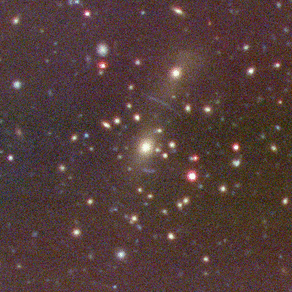
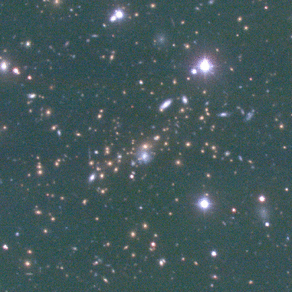
True color images of MS0302+1658 and MS0451-0305 showing blue giant arc systems. The image to the left is 512 x 512 pixel subarray equal to 750 x 750 kpc at z=0.426 for H=50, q0=0.5. The three color image for MS0302 was produced using V (5400s), R (6000s) and I (3000s) CCD frames. The image to the right is 750 x 750 pixel subarray equal to 1.2 x 1.2 Mpc at z=0.55 for H=50, q0=0.5. The three color image for MS0451 has been produced using V (8400s), R (7200s) and I (4200s) CCD frames. Observations were made at the UH 2.2m and Canada-France-Hawaii telescopes. Images are published in Luppino, Gioia, Hammer, Le Fevre & Annis, 1999.
Updated: Jun 2007